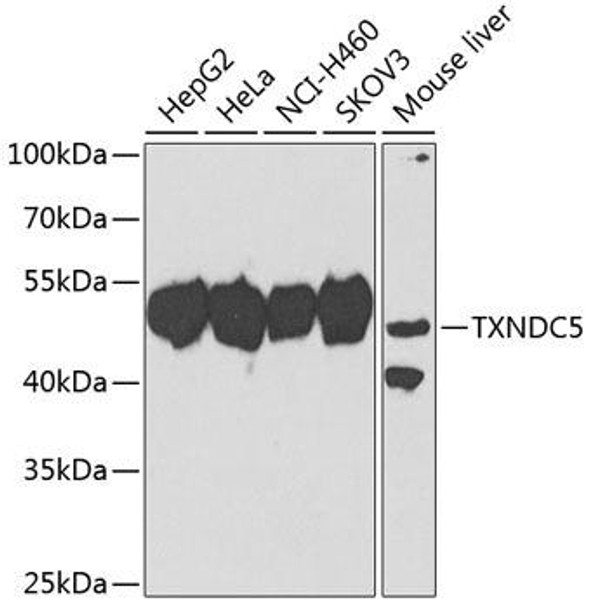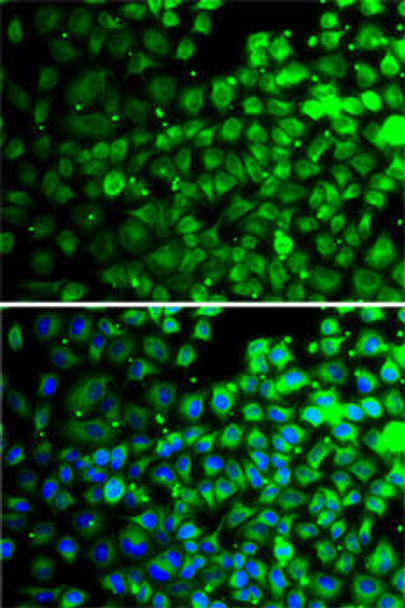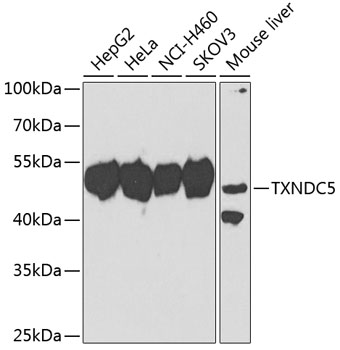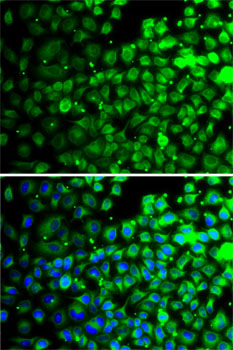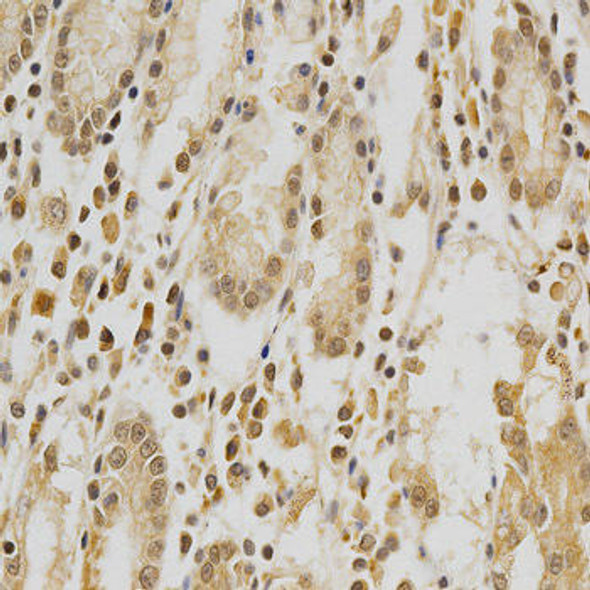Anti-TXNDC5 Antibody (CAB7315)
- SKU:
- CAB7315
- Product Type:
- Antibody
- Reactivity:
- Human
- Mouse
- Host Species:
- Rabbit
- Isotype:
- IgG
- Antibody Type:
- Polyclonal Antibody
- Research Area:
- Cell Biology
Description
Anti-TXNDC5 Antibody (CAB7315)
The TXNDC5 Polyclonal Antibody (CAB7315) is a valuable tool for researchers studying TXNDC5, a protein involved in redox regulation and stress response pathways. This antibody, produced in rabbits, exhibits high specificity and sensitivity towards human samples, making it ideal for use in various experimental techniques such as Western blotting.TXNDC5, also known as thioredoxin domain-containing protein 5, plays a crucial role in maintaining cellular redox balance and protecting cells from oxidative damage. Its involvement in regulating stress responses makes it an intriguing target for research in fields such as cancer biology, neurodegenerative diseases, and cardiovascular disorders.
By utilizing the TXNDC5 Polyclonal Antibody, researchers can accurately detect and analyze the expression of TXNDC5 in different cell types and tissues, providing valuable insights into its function and potential implications in various pathological conditions. This antibody is a valuable tool for advancing our understanding of TXNDC5 biology and its therapeutic potential in combating oxidative stress-related diseases.
| Antibody Name: | Anti-TXNDC5 Antibody |
| Antibody SKU: | CAB7315 |
| Antibody Size: | 20uL, 50uL, 100uL |
| Application: | WB IF |
| Reactivity: | Human, Mouse |
| Host Species: | Rabbit |
| Immunogen: | Recombinant fusion protein containing a sequence corresponding to amino acids 1-324 of human TXNDC5 (NP_001139021.1). |
| Application: | WB IF |
| Recommended Dilution: | WB 1:500 - 1:2000 IF 1:50 - 1:100 |
| Reactivity: | Human, Mouse |
| Positive Samples: | HepG2, HeLa, NCI-H460, SKOV3, Mouse liver |
| Immunogen: | Recombinant fusion protein containing a sequence corresponding to amino acids 1-324 of human TXNDC5 (NP_001139021.1). |
| Purification Method: | Affinity purification |
| Storage Buffer: | Store at -20'C. Avoid freeze / thaw cycles. Buffer: PBS with 0.02% sodium azide, 50% glycerol, pH7.3. |
| Isotype: | IgG |
| Sequence: | MEDA KVYV AKVD CTAH SDVC SAQG VRGY PTLK LFKP GQEA VKYQ GPRD FQTL ENWM LQTL NEEP VTPE PEVE PPSA PELK QGLY ELSA SNFE LHVA QGDH FIKF FAPW CGHC KALA PTWE QLAL GLEH SETV KIGK VDCT QHYE LCSG NQVR GYPT LLWF RDGK KVDQ YKGK RDLE SLRE YVES QLQR TETG ATET VTPS EAPV LAAE PEAD KGTV LALT ENNF DDTI AEGI TFIK FYAP WCGH CKTL APTW EELS KKEF PGLA GVKI AEVD CTAE RNIC SKYS VRGY PTLL LFRG GKKV SEHS GGRD LDSL HRFV LSQA KDEL |
| Gene ID: | 81567 |
| Uniprot: | Q8NBS9 |
| Cellular Location: | Endoplasmic reticulum lumen |
| Calculated MW: | 36kDa/47kDa |
| Observed MW: | 48kDa |
| Synonyms: | TXNDC5, ENDOPDI, ERP46, HCC-2, HCC2, PDIA15, STRF8, UNQ364 |
| Background: | This gene encodes a protein-disulfide isomerase. Its expression is induced by hypoxia and its role may be to protect hypoxic cells from apoptosis. Alternative splicing results in multiple transcript variants. Read-through transcription also exists between this gene and the neighboring upstream MUTED (muted homolog) gene. |
| UniProt Protein Function: | TXNDC5: Possesses thioredoxin activity. Has been shown to reduce insulin disulfide bonds. Also complements protein disulfide- isomerase deficiency in yeast. Belongs to the protein disulfide isomerase family. |
| UniProt Protein Details: | Protein type:Secreted; Secreted, signal peptide Chromosomal Location of Human Ortholog: 6p24.3 Cellular Component: lysosomal lumen; endoplasmic reticulum; endoplasmic reticulum lumen Molecular Function:protein binding; protein disulfide isomerase activity Biological Process: protein folding; cell redox homeostasis; post-Golgi vesicle-mediated transport; apoptotic cell clearance; negative regulation of apoptosis |
| NCBI Summary: | This gene encodes a member of the disulfide isomerase (PDI) family of endoplasmic reticulum (ER) proteins that catalyze protein folding and thiol-disulfide interchange reactions. The encoded protein has an N-terminal endoplasmic reticulum (ER)-signal sequence, three catalytically active thioredoxin domains and a C-terminal ER-retention sequence. Its expression is induced by hypoxia and its role may be to protect hypoxic cells from apoptosis. Alternative splicing results in multiple transcript variants. Read-through transcription also exists between this gene and the neighboring upstream BLOC1S5 gene. [provided by RefSeq, Dec 2016] |
| UniProt Code: | Q8NBS9 |
| NCBI GenInfo Identifier: | 29839560 |
| NCBI Gene ID: | 81567 |
| NCBI Accession: | Q8NBS9.2 |
| UniProt Related Accession: | Q8NBS9 |
| Molecular Weight: | |
| NCBI Full Name: | Thioredoxin domain-containing protein 5 |
| NCBI Synonym Full Names: | thioredoxin domain containing 5 |
| NCBI Official Symbol: | TXNDC5 |
| NCBI Official Synonym Symbols: | HCC2; ERP46; HCC-2; STRF8; PDIA15; UNQ364; ENDOPDI |
| NCBI Protein Information: | thioredoxin domain-containing protein 5 |
| UniProt Protein Name: | Thioredoxin domain-containing protein 5 |
| UniProt Synonym Protein Names: | Endoplasmic reticulum resident protein 46; ER protein 46; ERp46; Thioredoxin-like protein p46 |
| UniProt Gene Name: | TXNDC5 |
| UniProt Entry Name: | TXND5_HUMAN |

